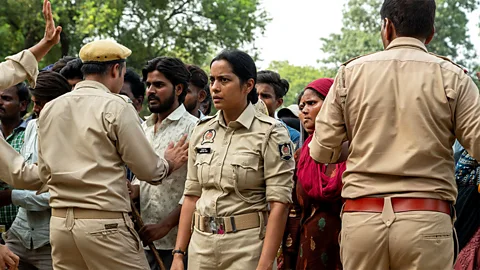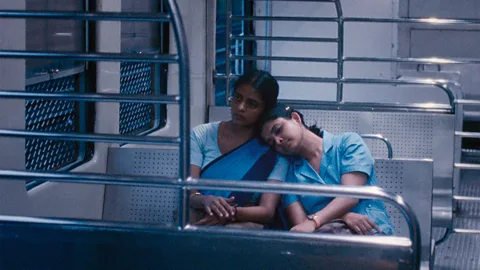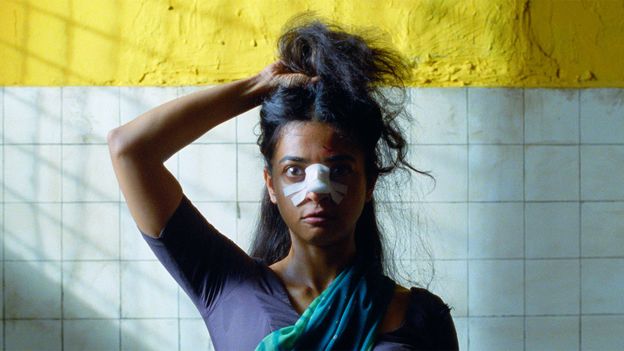 Altitude
AltitudeSister Midnight, Santosh and All We Imagine as Light are part of a new wave of female-centred Indian films challenging the roles of traditional Bollywood heroines.
They’re unpredictable, sometimes humorous, sometimes sexually adventurous, and they’re all leading characters, rather than orbiting a man. The heroines of films including Sister Midnight, Santosh, Girls Will Be Girls, All We Imagine as Light and Shadowbox are giving international audiences a chance to see female characters from India who differ from most traditional Bollywood heroines. But do Indian audiences want to watch them – or will they even be able to?
A feral bride in an arranged marriage that neither she nor the groom particularly want, Uma is the protagonist of Karan Kandhari’s spiky comedy Sister Midnight, which premiered at the 2024 Cannes Film Festival and was nominated for a Bafta. Well-known Bollywood actress Radhika Apte, who plays her, is shown struggling with household chores. “Men are dim,” her neighbour tells her. “They’ll eat anything. Just add chilli and salt.” Uma informs her awkward groom, who has gone on a week-long drinking binge, that he “stinks” and tells her employers sarcastically when they offer her a cleaning job that she’s “a domestic goddess”.
Told through offbeat dialogue, physical comedy and a punkish soundtrack that includes Iggy Pop, Sister Midnight presents a heroine unlike anything else filmed in India, according to Apte. “I’d never read anything like it before and I couldn’t put it down,” she tells the BBC. “I was completely taken by Uma, she was this crazy creature, and I didn’t know why I resonated with her, but I just did. It was going to be a very thin line playing her between it being really cool and it going wrong. And that excited and challenged me. I also like how unapologetic Uma is and the more she accepts herself, the freer and stronger she becomes.”
 Altitude
AltitudeUma is the latest character that offers a different kind of female protagonist to Indian viewers, one who differs markedly from the traditional Bollywood heroine. “Bollywood”, the name for Hindi-language studio cinema, has historically dominated the Indian box office, making around $1.36bn last year. But it’s also been accused of being “sexist and regressive” in its attitude towards women. In 2023, a landmark study in India examined some of the country’s biggest hits in terms of gender representation and sexual stereotyping, and found what they described as a “formula” to many of Bollywood’s female characters.
“The female lead has to be thin and beautiful. She has to be coy and demure who expresses consent through gestures rather than words, but [she] wears sexually revealing clothing and has to be somewhat modern to allow for her to be in a pre-marital relationship which is a transgression,” Professor Lakshmi Lingam, the project lead for the study, told the BBC at the time. “There’s very little attempt to do something different.”
The depiction of both male and female characters on screen is important, she added, because “in India, where families and schools rarely teach about sex education and consent, all our responses are influenced by books and cinema”.
By contrast, the male stars of the biggest Bollywood films of 2023 were described as “led by alpha male protagonists with rippling muscles and blazing guns brandished on screen as they went on a bone-crunching rampage to vanquish their enemies”. The hit films included Shah Rukh Khan’s Pathaan and Jawan, in which he plays a spy and vigilante, as well as the much-criticised, hyper-violent Animal, starring Ranbir Kapoor, a film accused of misogyny and objectifying women. It was made by Sandeep Reddy Vanga, whose previous film Kabir Singh showed the male lead openly stalking and harassing a woman and was the second biggest Bollywood movie of 2019.
Changing the narrative
There have been hit films showing women in roles of authority, including female rocket scientists in Mission Mangal, also one of the most successful Bollywood films of 2019, and films praised for a modern perspective on gender roles, such as Karan Johar’s Rocky aur Rani Kii Prem Kahaani (Rocky and Rani’s Love Story). But nevertheless Shubhra Gupta, the film critic for daily newspaper The Indian Express, laments the lack of “wriggle room” India’s leading ladies generally have in their roles.
“These heroines’ overriding principle is demureness,” she tells the BBC. “You can have flashes of spirit, or you may speak your mind, but you’d also be just right in terms of beauty, and you’d be very clearly subservient to the leading man and whatever he is doing. You are pretty much always bringing up the rear, with a few scenes in which you get to shine.”
In Sandhya Suri’s recent drama Santosh, however, a Dalit woman (from the lowest caste in Hindu society) is as a police officer, with the authority that brings. Santosh inherits her husband’s police officer job when he dies in service, something that’s possible on compassionate grounds for government employees in India. Santosh, played by Shahana Goswami, is an enigmatic character who finds corruption in her local police force when a young girl is raped and murdered. She has a female boss, played by film and TV actress Sunita Rajwar, who has learned to compromise to stay at the top.
 TIFF
TIFFSuri, previously a documentary maker, says she was influenced in making it by the real-life gang rape and murder in 2012 of a young woman on a bus in Delhi, which made worldwide headlines and led to new laws to safeguard women. (Despite that, sexual violence against women and girls remains high in India, and a 2022 report found that cruelty by a husband or his relatives remained the biggest crime against Indian women.)
“There were big protests at the time [of the rape and murder], and I saw the photo of a female cop being confronted by some very angry female protestors. I saw that image and I saw the expression on the cop’s face, and it was so enigmatic that I was just very, very taken by it. It was so interesting. She was at both ends of power. There was the possibility of violence against her, but [it was] also possible for her to mete out violence as well with that uniform,” Suri tells the BBC.
“I wanted to know if you took somebody like Santosh, shut up in the kitchen of her house, and you put her in that place, what’s her response to that?” she explains. “I wanted to ask if there was a way to be a woman that’s not about being a man, and not about being oppressed. Is there some other way in her society in which she can be, and that there may be a line she steps over?”
Santosh, which was made in Hindi, was the UK’s Oscar entry for best international film in 2025 – one attribute both Sister Midnight and Santosh share is that, though they were filmed in India, they’re made by British Indian film-makers. Sister Midnight’s makers hope to release it in India in 2025, but Suri tells the BBC that Santosh will almost certainly not get a cinema release there.
“We screened it at the Mumbai International Film Festival and had a great response, and I was moved by just how real the film felt to a local audience,” she says. “But it looks like the film won’t release in India, sadly, as it was admitted to the censor board (CBFC) and there were so many cuts, I couldn’t maintain some semblance of a film.”
Censorship in India
Indian censorship decisions have frequently caused controversy: in 2017, the decision to ban the feminist Indian movie Lipstick Under My Burkha for being “too lady oriented” caused an outcry, and was later overturned after negative publicity. But many homegrown blockbusters are self-censoring, especially when it comes to sex and sexuality.
The 2021 Telugu-language hit Pushpa: The Rise, the story of a smuggler, removed a scene where the hero Pushpa (played by Allu Arjun) touches the chest of the heroine, Srivalli, because of complaints from the audience. In 2024, Pushpa 2: The Rule again caused controversy in India, according to Shubhra Gupta, because of an insinuation that Srivalli (played by Rashmika Mandanna) might want to be sexually intimate with her husband.
“The [female] character acts very cute, she comes on to the hero and is very playful when she wants a little assignation,” Gupta says of it. “The rest of the film she’s serving the hero. She wants her husband not to have sex with anyone else. But in fact, it became a real talking point in India because it’s not something heroes or leading ladies in the movies are supposed to have conversations about.
“And our mainstream film experience is still very much that if a woman has a sexual experience outside marriage, there will be some castigation attached to it,” she adds. “She won’t be ‘pure’ anymore, she’ll be known as ‘bold’ which means she’s been around.”
It makes Payal Kapadia’s acclaimed film All We Imagine as Light seem more audacious in terms of its exploration of sex. The first ever Indian winner of the Cannes Film Festival’s Grand Prix is the story of a nurse, Prabha, who’s been abandoned in her arranged marriage. Meanwhile, her younger flatmate Anu, a Hindu, wants to get intimate with her Muslim boyfriend, itself another taboo. There’s no talk of marriage in advance.
“The film’s about the preoccupations I’ve had for some time,” Kapadia tells the BBC. “Women in India can be financially independent, but there is still not a lot of autonomy with what you choose to do with your personal life. It’s infantilising women. You could be 25 years old, making your own money, providing for your family back home. But you can’t decide who to be with or who to marry.”
Despite the accolades, All We Imagine as Light was not chosen as India’s 2025 Oscar entry (the deciding jury called it “a European film taking place in India”.) But it wasn’t the only film by an Indian female director in 2024 that put a young woman’s sexual awakening on screen – the English and Hindi language movie Girls Will Be Girls, by Shuchi Talati, won the audience award at the Sundance Film Festival. Set in a boarding school in the Himalayas, it’s the story of an 18-year-old girl who falls in love with a boy for the first time, but whose romance is disrupted by her mother.
 CMPR
CMPRBut Indian films breaking societal “norms” have found international recognition before, from Mira Nair’s Monsoon Wedding (2001), to Lipstick Under My Burkha (2016), and 2014’s LGBTQ+ teenage love story, Margarita with a Straw. Shubhra Gupta says there’s still a vast gap between what an international audience react to and what mainstream Indian audiences will pay to see, given the high ticket prices in cinemas.
“These films we’re talking about are part of independent Indian film, which is really where all the exciting things happen, and that’s pretty much true of all world cinema,” she says. “Payal Kapadia has had a fabulous journey with All We Imagine as Light, and it did get a cinema release here. But I’m not sure how much box office it made in India.” She adds that many viewers in India would react in “disbelief” to heroines such as Sister Midnight’s Uma and Santosh were they able to watch the movies, as they are so unconventional.
“They wouldn’t be able to suspend disbelief that in Santosh, a Dalit woman from the lower caste, would be made into the lead, that she’s driving the narrative. It would be such a hard sell here,” she says. “And Radhika Apte’s character Uma is a wife, but she is not submissive. She goes out there and does all these mad things. They are excellent films that might do well on a streaming platform, or they will find a discerning audience – but a discerning audience doesn’t really make up the numbers that a big budget Bollywood film will.”
Breaking stereotypes
But Indian film-makers still have to try to break stereotypes for audiences, according to Tanushree Das and Saumyananda Sahi, the directors behind Bengali-language film Shadowbox. The film, shown at this year’s Berlin International Film Festival, is the story of Maya, (played by Tillotama Shome) who holds down several jobs and battles to keep her family going because her husband, a former soldier, struggles with his mental health and is frequently humiliated by the community because of it.
“When we’re talking about working class underprivileged women, the term ‘from the margins’ tends to crop up,” Das tells the BBC. “But the ‘margin’ represents a huge majority of our population. Where are their stories, then? It’s high time we broke stereotypes, and to do this more women need to tell their own stories. I feel producers and distributors of film underestimate how large a viewership women represent, and their appetite to see stories where their lives are mirrored rather than projected in a tokenistic way.”
 CMPR
CMPRIf cinema itself is not an option, the rise of the international streamers and OTT platforms (which allow viewers to watch content directly on their TV or through a phone app) during the Covid-19 pandemic has provided a place for recent, more audacious, female-focused film-making. The Great Indian Kitchen in 2021 by Jeo Baby, a Malayalam language film, became a hit on the app Neestream, and versions of the story were also made in Tamil and Hindi. It’s the story of an arranged marriage, and the film shows, from a female viewpoint, household drudgery, unpleasant in-laws and monotonous and painful sex with an uncaring husband, with one female critic saying of it that “the film rips through patriarchy, the bedrock of the institutions of family and religion.”
Laapataa Ladies, by Kiran Rao (which did become India’s Oscar entry this year) also deals with an unwanted arranged marriage and was released on Netflix, as was 2020’s Gunjan Saxena, which told the story of India’s first ever female fighter pilot.
“But people are not actually buying a ticket for these,” Gupta says. “It’s mostly 15-to 35-year-olds who are going to the movies, and often they happen to be young men. And the film industry is still a boy’s club to a large extent.”
For more nuanced female characters to be seen in big-budget cinema films, ultimately Bollywood’s lack of profits last year might be an impetus. After its bumper 2023, last year Bollywood only achieved 40% of the overall Indian box office profits, and Gupta says its “formulaic films” are part of the problem. “People are hungry for something different,” she says. “But the problem is, if you take them too far out of their comfort zone, I’m not sure whether they’re going to come to the cinema. So unfortunately, we’ve ended up maintaining this equilibrium so that people will come to the movies not expecting to see women who are feminists, or women who do not ascribe to the idea of what a good woman should be.”
However, she adds, it’s not just female characters who have to be written differently in order for change to come. “I would say that if you want your women characters to be different, you also have to write your men differently too,” says Gupta. “There needs to be a cosmic shift across the board.”
Santosh and Sister Midnight are currently on release in the UK. Sister Midnight will be released in the US on 16 May 2025.









